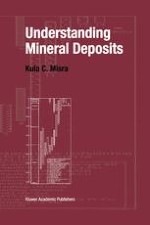
2000 | OriginalPaper | Buchkapitel
Introduction
verfasst von : Kula C. Misra
Erschienen in: Understanding Mineral Deposits
Verlag: Springer Netherlands
Enthalten in: Professional Book Archive
Aktivieren Sie unsere intelligente Suche, um passende Fachinhalte oder Patente zu finden.
Wählen Sie Textabschnitte aus um mit Künstlicher Intelligenz passenden Patente zu finden. powered by
Markieren Sie Textabschnitte, um KI-gestützt weitere passende Inhalte zu finden. powered by
A mineral deposit (or an ore deposit) may be defined as a rock body that contains one or more elements (or minerals) sufficiently above the average crustal abundance to have potential economic value. It has been a common practice to classify mineral deposits into two broad categories: (a) metallic mineral deposits (e.g., deposits of copper, lead, zinc, iron, gold, etc.), from which one or more metals can be extracted; and (b) nonmetallic (or industrial) mineral deposits (e.g., deposits of clay, mica, fluorite, asbestos, garnet, etc.), which contain minerals useful on account of their specific physical or chemical properties. The minerals of economic interest in a deposit are referred to as ore minerals and the waste material as gangue. Accessory sulfide-group and oxide-group minerals (e.g., pyrite, arsenopyrite, magnetite, ilmenite), especially in metallic mineral deposits, however, are sometimes described as ore minerals, although they actually constitute part of the gangue.